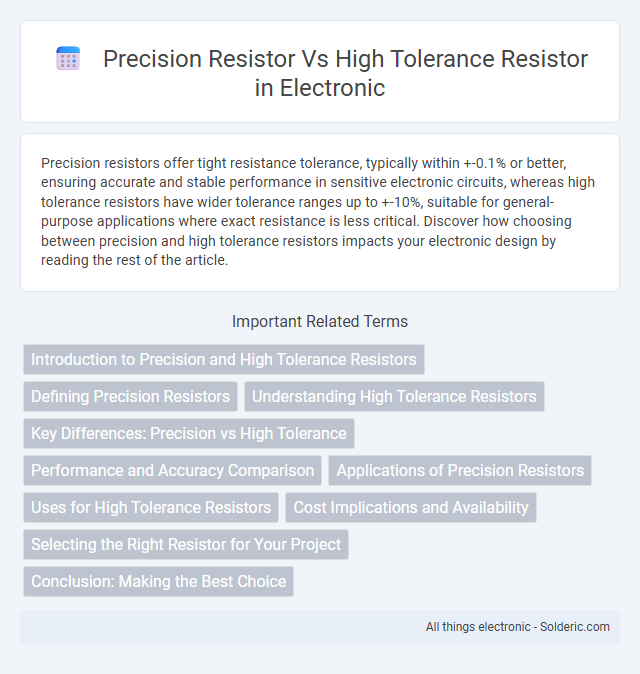Precision resistors offer tight resistance tolerance, typically within +-0.1% or better, ensuring accurate and stable performance in sensitive electronic circuits, whereas high tolerance resistors have wider tolerance ranges up to +-10%, suitable for general-purpose applications where exact resistance is less critical. Discover how choosing between precision and high tolerance resistors impacts your electronic design by reading the rest of the article.
Comparison Table
| Feature | Precision Resistor | High Tolerance Resistor |
|---|---|---|
| Resistance Accuracy | +-0.01% to +-0.1% | +-1% to +-5% |
| Use Case | Critical circuits requiring exact resistance | General purpose, non-critical applications |
| Cost | Higher cost due to tighter specs | Lower cost |
| Temperature Coefficient | Low (ppm/degC range) | Higher (typically 100+ ppm/degC) |
| Stability | High stability over time and conditions | Moderate stability |
| Applications | Precision measurement, calibration, audio equipment | Power supplies, general electronics |
Introduction to Precision and High Tolerance Resistors
Precision resistors maintain resistance values with minimal deviation, typically within +-0.1% or better, making them ideal for applications requiring high accuracy and stability. High tolerance resistors have wider resistance variation limits, often around +-1% to +-5%, suitable for general-purpose circuits where exact resistance is less critical. The choice between precision and high tolerance resistors depends on the application's demands for accuracy, stability, and cost-efficiency.
Defining Precision Resistors
Precision resistors are electronic components designed to maintain extremely accurate resistance values, typically within +-0.1% tolerance or better, making them essential in circuits demanding high accuracy and stability. Unlike high tolerance resistors, which can have tolerances ranging from +-1% to +-10%, precision resistors ensure minimal variation in resistance due to temperature changes and aging. These resistors are commonly used in measurement instruments, calibration equipment, and high-performance analog circuits where exact resistance is crucial for reliable operation.
Understanding High Tolerance Resistors
High tolerance resistors typically have a resistance variation of +-5% or more, making them less precise but more cost-effective for general applications. Precision resistors, by contrast, offer tighter tolerance levels of +-1% or lower, ensuring greater accuracy and stability in sensitive electronic circuits. Understanding high tolerance resistors helps you select the right component for non-critical applications where minor resistance variations do not affect overall performance.
Key Differences: Precision vs High Tolerance
Precision resistors offer extremely low tolerance levels, typically around +-0.1% or better, ensuring highly accurate and stable resistance values critical for sensitive electronic circuits. High tolerance resistors, in contrast, have broader tolerance ranges commonly from +-5% to +-10%, making them suitable for general-purpose applications where exact resistance is less crucial. The main difference lies in the manufacturing process and material quality, with precision resistors requiring tighter controls to maintain consistent performance in demanding environments.
Performance and Accuracy Comparison
Precision resistors offer superior accuracy with tolerance levels as low as +-0.01%, ensuring minimal deviation from specified resistance values for high-performance applications. High tolerance resistors typically have wider tolerance ranges, such as +-5%, which can lead to greater variability in circuit performance and less predictable results. Your choice between the two depends on the required precision and stability in electronic circuits where exact resistance values are critical.
Applications of Precision Resistors
Precision resistors are essential in applications demanding exact resistance values, such as calibration equipment, aerospace instrumentation, and medical devices, where even minute variations can impact performance. Their low tolerance levels, often within +-0.1% or better, ensure consistent and accurate signal processing in precision measurement systems and high-frequency circuits. High tolerance resistors, by contrast, are typically used in less critical applications where cost-efficiency outweighs the need for precise resistance control.
Uses for High Tolerance Resistors
High tolerance resistors are primarily used in applications where exact resistance values are not critical, such as in general-purpose electronic devices, consumer electronics, and power distribution systems. These resistors provide cost-effective solutions for filtering, voltage division, and current limiting where minor variations in resistance do not affect overall circuit performance. Ideal for environments with relaxed accuracy requirements, high tolerance resistors ensure reliable operation in everyday electronics without the expense of precision components.
Cost Implications and Availability
Precision resistors typically incur higher costs due to stringent manufacturing processes and tighter tolerance specifications, making them less economically viable for large-scale, low-cost applications. High tolerance resistors offer greater availability and lower prices as they tolerate broader resistance ranges, reducing production complexity and enhancing supply chain flexibility. The choice between these resistor types hinges on balancing cost demands with performance requirements and component accessibility.
Selecting the Right Resistor for Your Project
Selecting the right resistor for your project depends on the required accuracy and application sensitivity; precision resistors provide tight resistance tolerance typically within +-0.1% or better, ensuring consistent and reliable performance in critical circuits. High tolerance resistors, often with +-5% or higher tolerance, are suitable for general-purpose uses where exact resistance values are less crucial and cost-effectiveness is prioritized. Evaluating the acceptable resistance variation and the impact on circuit functionality guides the choice between precision and high tolerance resistors for optimal project outcomes.
Conclusion: Making the Best Choice
Choosing between a precision resistor and a high tolerance resistor depends on the specific accuracy requirements and application demands. Precision resistors offer extremely low tolerance values, typically within +-0.1% or better, ensuring reliable performance in critical circuits, while high tolerance resistors, with wider tolerance ranges around +-5% or more, suit less demanding applications where cost efficiency matters. Selecting the best resistor involves balancing performance needs, budget constraints, and the impact of tolerance on overall circuit functionality.
Precision resistor vs high tolerance resistor Infographic

 solderic.com
solderic.com